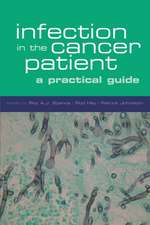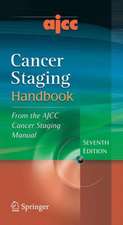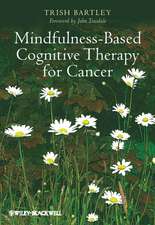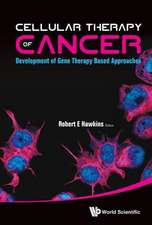Tumor-Induced Immune Suppression: Mechanisms and Therapeutic Reversal
Editat de Dmitry I. Gabrilovich, Arthur Andrew Hurwitzen Limba Engleză Paperback – 27 aug 2016
The last decades were characterized by substantial progress in the understanding of the role of the immune system in tumor progression. Researchers have learned how to manipulate the immune system to generate tumor specific immune response, which raises high expectations for immunotherapy to provide breakthroughs in cancer treatment. It is increasingly clear that tumor-induced abnormalities in the immune system not only hampers natural tumor immune surveillance, but also limits the effect of cancer immunotherapy. Therefore, it is critically important to understand the mechanisms of tumor-induced immune suppression to make any progress in the field and this monograph provides these important insights.
| Toate formatele și edițiile | Preț | Express |
|---|---|---|
| Paperback (2) | 1088.92 lei 6-8 săpt. | |
| Springer – 29 oct 2010 | 1088.92 lei 6-8 săpt. | |
| Springer – 27 aug 2016 | 1419.76 lei 6-8 săpt. | |
| Hardback (1) | 1424.89 lei 6-8 săpt. | |
| Springer – 10 feb 2014 | 1424.89 lei 6-8 săpt. |
Preț: 1419.76 lei
Preț vechi: 1494.49 lei
-5% Nou
Puncte Express: 2130
Preț estimativ în valută:
271.80€ • 283.59$ • 227.84£
271.80€ • 283.59$ • 227.84£
Carte tipărită la comandă
Livrare economică 13-27 martie
Preluare comenzi: 021 569.72.76
Specificații
ISBN-13: 9781493950515
ISBN-10: 1493950517
Pagini: 478
Ilustrații: XIV, 464 p. 38 illus., 34 illus. in color.
Dimensiuni: 155 x 235 x 25 mm
Greutate: 0.67 kg
Ediția:Softcover reprint of the original 2nd ed. 2014
Editura: Springer
Colecția Springer
Locul publicării:New York, NY, United States
ISBN-10: 1493950517
Pagini: 478
Ilustrații: XIV, 464 p. 38 illus., 34 illus. in color.
Dimensiuni: 155 x 235 x 25 mm
Greutate: 0.67 kg
Ediția:Softcover reprint of the original 2nd ed. 2014
Editura: Springer
Colecția Springer
Locul publicării:New York, NY, United States
Cuprins
Preface.- Regulatory T Cells and Cancer.- Th17 cells in cancer.- Mast cells and immune response in cancer.- Myeloid-Derived Suppressor Cells in Tumor-Induced T-Cell Suppression and Tolerance.- Immunobiology of Dendritic Cells in Cancer.- Macrophages and Tumor Development.- Angiogenesis and Immune Suppression in Cancer.- Tim-3 Regulation of Cancer Immunity.- Transcriptional Regulation of Dendritic Cells in The Tumor Microenvironment.- S100A9, Inflammation, and Regulation of Immune Suppression in Cancer.- IDO in Inflammatory Programming and Immune Suppression in Cancer.- Defining the Fate and Function of Effector T cells through Galectin-1 – Galectin-1 Ligand Binding Interactions: Implications in Tumor Immunity.- Arginine Metabolism, a Major Pathway for the Suppressive Function of Myeloid-derived Suppressor Cells.- The Hypoxia-Adenosinergic Immunosuppression and Redirection of Immune Response in Tumor Microenvironment.- Molecular Pathways in Antigen Presenting Cells Involved in the Induction of Antigen-Specific T-Cell Tolerance.- Overcoming Immune Suppression: Therapeutic Strategies Targeting T-Cell Function in Cancer.- Index.
Textul de pe ultima copertă
Tumor-Induced Immune Suppression - Prospects and Progress in Mechanisms and Therapeutic Reversalpresents a comprehensive overview of large number of different mechanisms of immune dysfunction in cancer and therapeutic approaches to their correction. This includes the number of novel mechanisms that has never before been discussed in previous monographs.
The last decades were characterized by substantial progress in the understanding of the role of the immune system in tumor progression. Researchers have learned how to manipulate the immune system to generate tumor specific immune response, which raises high expectations for immunotherapy to provide breakthroughs in cancer treatment. It is increasingly clear that tumor-induced abnormalities in the immune system not only hampers natural tumor immune surveillance, but also limits the effect of cancer immunotherapy. Therefore, it is critically important to understand the mechanisms of tumor-induced immune suppression to make any progress in the field and this monograph provides these important insights.
The last decades were characterized by substantial progress in the understanding of the role of the immune system in tumor progression. Researchers have learned how to manipulate the immune system to generate tumor specific immune response, which raises high expectations for immunotherapy to provide breakthroughs in cancer treatment. It is increasingly clear that tumor-induced abnormalities in the immune system not only hampers natural tumor immune surveillance, but also limits the effect of cancer immunotherapy. Therefore, it is critically important to understand the mechanisms of tumor-induced immune suppression to make any progress in the field and this monograph provides these important insights.
Caracteristici
Features extensive updates to the original edition and several new chapters Presents a comprehensive overview of different mechanisms of immune dysfunction Discusses a number of new mechanisms that have never been discussed in a monograph report including: T-cell inhibitory molecules and regulatory tolergenic DCs Includes supplementary material: sn.pub/extras
Recenzii
From the reviews:
"The overall goal of this book is to describe what is currently known about the ways tumors circumvent destruction by the host’s immune system. … The book is targeted at researchers -- immunologists in general and, more specifically, tumor immunologists. It also provides a good source of information for graduate students and postdoctoral fellows. The editors of the book and the authors of the chapters are authorities in the areas they discuss. … a useful addition to the field." (Marion C. Cohen, Doody’s Review Service, August, 2008)
"The overall goal of this book is to describe what is currently known about the ways tumors circumvent destruction by the host’s immune system. … The book is targeted at researchers -- immunologists in general and, more specifically, tumor immunologists. It also provides a good source of information for graduate students and postdoctoral fellows. The editors of the book and the authors of the chapters are authorities in the areas they discuss. … a useful addition to the field." (Marion C. Cohen, Doody’s Review Service, August, 2008)















